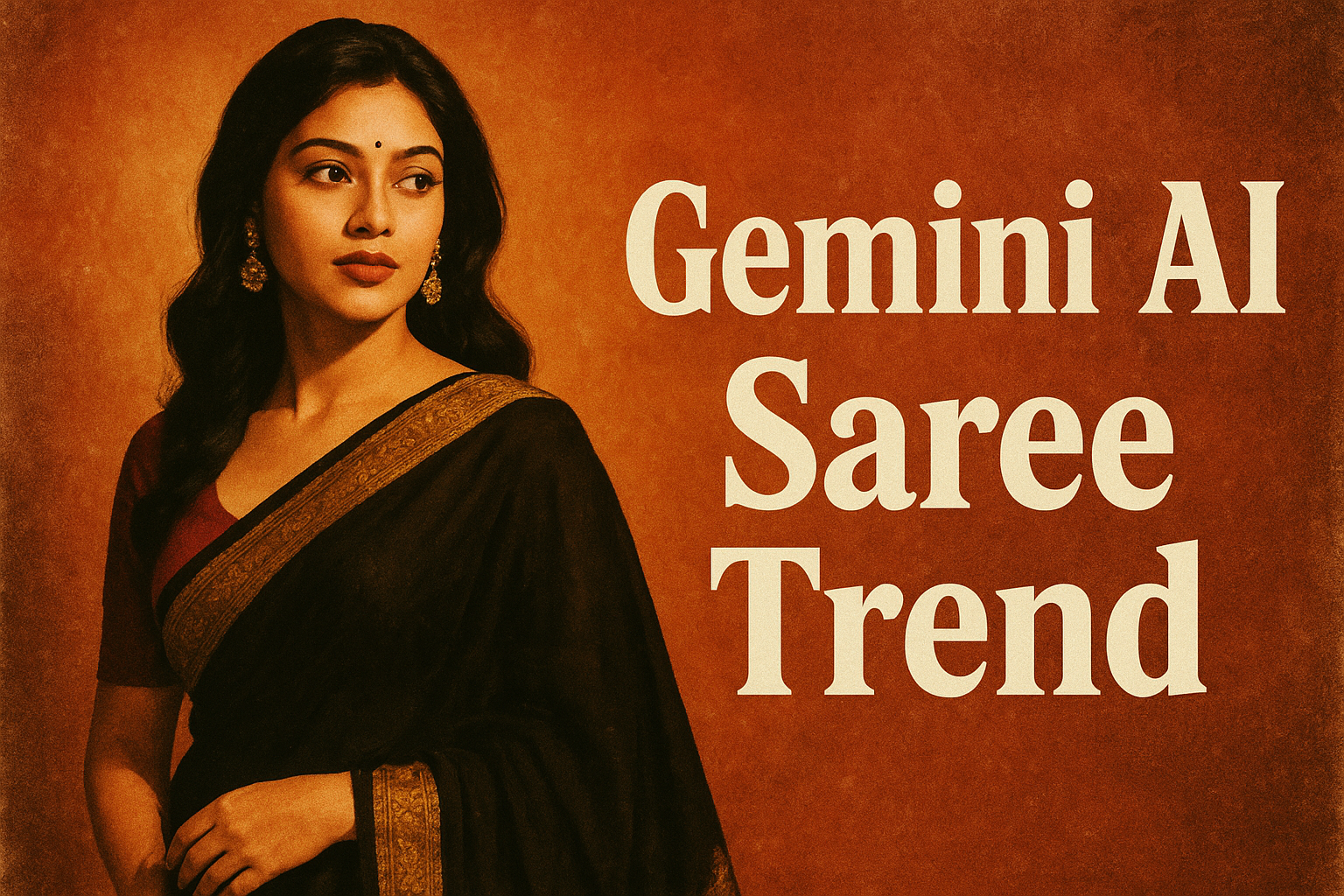The Viral Wave: Gemini AI Saree Trend & What It Tells Us About Our Culture
In the swirl of digital culture, some trends are fleeting, and others reveal deeper shifts in how we present ourselves, our heritage, and how technology reshapes those narratives. The Gemini AI saree photo trend is one such phenomenon. Powered by Google’s Gemini Nano Banana tool, it’s not just about retro aesthetics—it’s about identity, nostalgia, and how tradition adapts in the age of AI.
What Is the Gemini AI Saree Trend?
-
Users are transforming selfies into retro Bollywood-style portraits, often wearing sarees digitally, complete with dramatic lighting, vintage colour palettes, film-grain textures, and cinematic poses.
-
Prompts like “Classic Black Saree”, “Rainy Bollywood Scene”, “Banarasi Golden Glow” and others let people choose styles, moods and settings. It’s about choosing which part of nostalgia you want to embody.
-
The visuals evoke Indian film posters from the 80s-90s, old magazine covers, or Bollywood glamour—elements many grew up watching or wishing they had seen. There’s a shared cultural memory.
Why It’s Resonating Deeply
-
Nostalgia & Retro Glamour
The trend taps into collective nostalgia—those memories of filmi heroines in sarees, classic aesthetics, songs, drama. In a fast-changing world, revisiting these images gives comfort, identity, and a sense of continuity. -
Digital Self-Expression
In social media, appearance and image play a large role. This trend gives people the tools to present themselves as they wish—glamorous, cinematic, stylish—beyond constraints of real life. No need for expensive photoshoots or perfect lighting; AI does much of the heavy lifting. -
Tradition Meets Tech
The saree is one of the strongest symbols of traditional Indian attire. Using AI to digitally “wear” sarees or style them creatively highlights how tradition is being reinterpreted, not replaced. It’s a fusion: tech as a medium to celebrate culture. But it also raises questions—about authenticity, ownership of style, what’s real vs what’s generated. -
Accessibility
Many cannot afford professional fashion photography, stylists, or even high-end equipment. These tools level the playing field: anyone with a phone and internet can create visually striking imagery. -
Memes, Humor & Social Commentary
The trend also has its pundits and satire—some people question the irony of using AI for something many already own (i.e. actual sarees). These reactions become part of the trend, and bring in debates about digital vs tangible culture.
Potential Downsides & Ethical Questions
-
Cultural Dilution vs Appropriation
When trends go viral, there’s a risk that the deeper meanings of the sari and regional styles are flattened into “Bollywood glam”. Are we forgetting regional identities or craftsmanship? -
Privacy & AI Bias
AI tools often depend on large training data sets. There may be biases (skin tones, facial features) baked in, or concerns about how images are stored/used. Who owns the image you generate? What if it’s misused? -
Over-idealization & Unreachable Beauty Standards
These AI-styled images can produce hyperglamorous images that may set unrealistic expectations. When so many curated/synthetic visuals feed into what passes for “beauty”, real everyday appearance might feel lacking.
What It Means for Creators, Brands & Culture
-
Creators can ride the trend for engagement: stylists, fashion bloggers, photographers might incorporate AI generated/assisted content; nostalgic throwbacks will be in demand.
-
Brands in fashion might launch campaigns inspired by retro looks—reviving textile designs, prints, or email campaigns using AI-styled visuals. AI tools can also reduce production cost for mockups and styling experiments.
-
Cultural Preservationists might use this moment to remind people of the roots: handloom, regional saree styles (Banarasi, Kanjeevaram, Sambalpuri, etc.), craftsmanship stories. There’s a chance to bridge the digital and the artisanal.
How to Participate Mindfully
If you’re thinking of joining the trend (or already are), here are some tips:
-
Try using regional saree styles or lesser-known designs to bring something new.
-
Credit the style or origin if known (“Inspired by Banarasi”, etc.), to spread awareness.
-
Use AI tools but keep authenticity: you can combine digital with real — wear a real saree and enhance with filters or AI.
-
Be mindful of overuse of unrealistic filters—celebrate natural beauty too.
-
Understand and read terms of service of tools: what happens to your data? How are images used?
Beyond the Trend: What’s Coming Next?
-
Expect more AI style mashups: not just sarees, but traditional wear from different Indian regions; perhaps cross-cultural fusion (Indian + African, etc.).
-
AI tools might get better in capturing fabric texture, drape, detailing—making digital sarees more “real” visually.
-
Trends like virtual fashion shows, AR try-ons, digital wardrobes could become more mainstream.
-
Pushback or balanced content may emerge: highlighting handloom, sustainable fashion, slow fashion, artisan voices.
Conclusion
The Gemini AI saree trend is more than just pretty visuals. It’s a mirror showing what many of us want in our digital lives: nostalgia, identity, creativity, ease, and a bridge between heritage and modernity. As with any powerful tool, it comes with responsibilities—of preserving culture, of being aware of authenticity, and of using technology to uplift, not erase, stories.
Visit: http://aaopadhein.org
Also Read : Samsung Galaxy A58 5G: 350MP कैमरा, 8400mAh बैट्री और 80W फास्ट चार्जिंग
